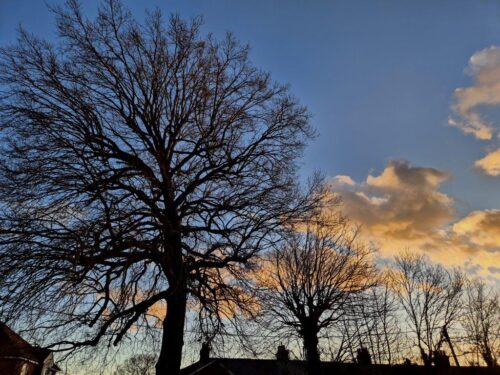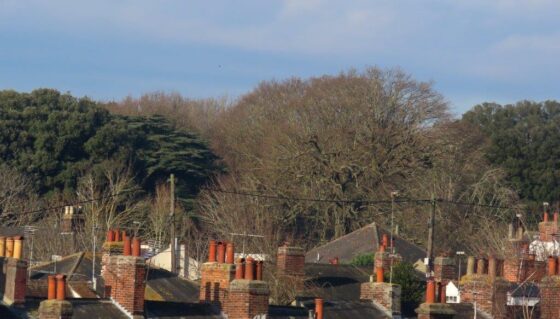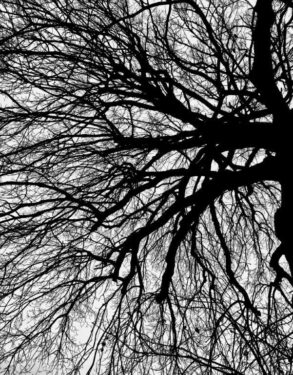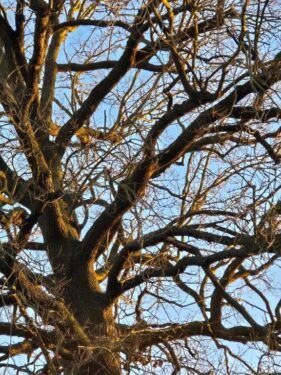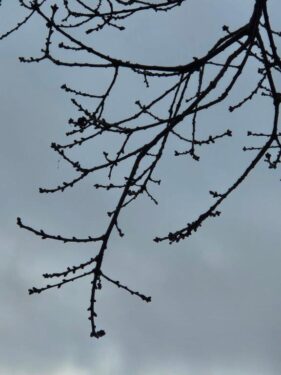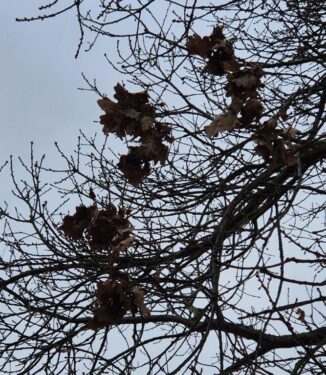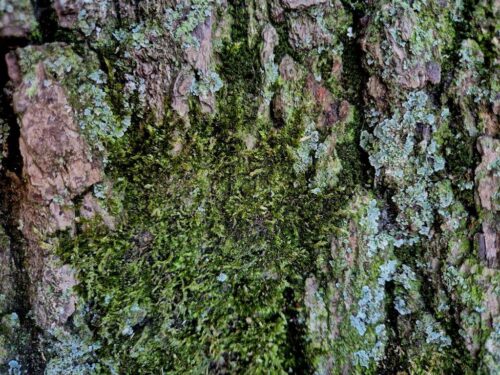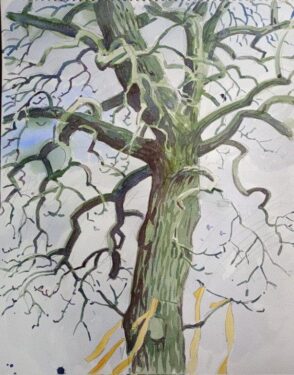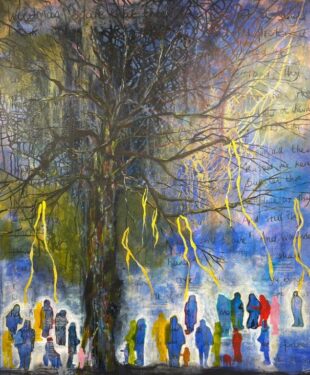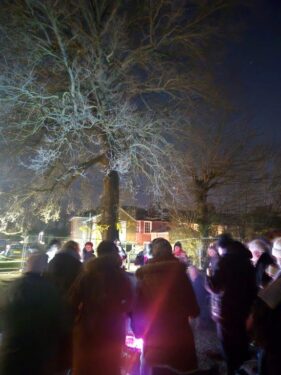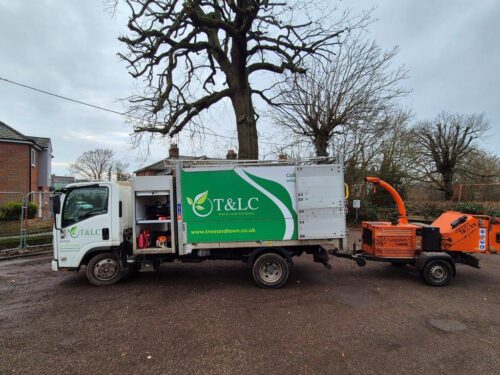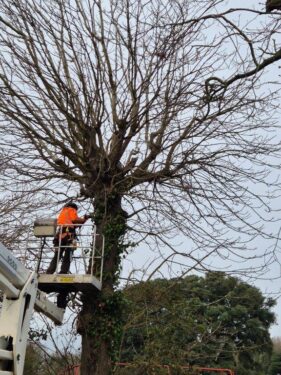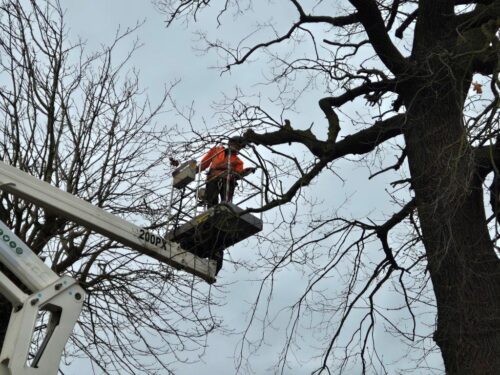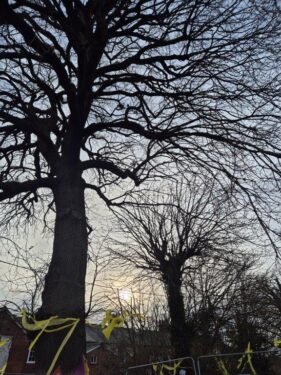Setting the scene
There is a tree in Wivenhoe that everyone knows. It is a Pedunculate Oak, with a hideous straitjacket of tarmac right up to its trunk, in the public car park at the bottom of the King George V field, the former front lawn of the long-gone Wivenhoe Hall.
This tree can be seen from vantage points across the town: even at nearly a kilometre from our flat, it is the tallest feature on our north-western skyline, except for St Mary’s Church. It is seen by everyone parking, playing in the park, walking past on the way to and from the station, or sitting in the window of the Greyhound Pub.
It is not the oldest of trees, maybe 180-200 years old, nor the most stately. But it is truly iconic to the people of Wivenhoe. It began life as a boundary tree of the Wivenhoe Hall estate, and then when little more than a sapling in 1863 witnessed the excavation of a precipitous gorge just a few tens of metres away – the arrival of the railway. Around that same time, a row of houses, Clifton Terrace, was built on spoil from the cutting lying over a slippery clay subsurface, between the tree and the railway. If ever there was a situation for storing up problems for the future it was this: general migration railwaywards could have been foreseen. Thankfully there were plenty of trees along the Hall estate boundary, which in full summer flow transpired huge volumes of water from the clay surface into the air, but despite this the terrace has long been subject to movement and instability, in many of the buildings necessitating underpinning.
In the later decades of the 20th century, when Wivenhoe Town Council assumed responsibility for the car park from Colchester, town councillors were steadfast in their defence of the tree, by now part of the village psyche.
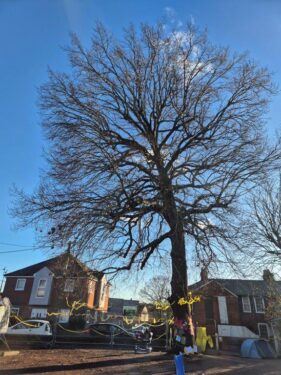 But no longer, it seems. Bullied by Aviva, insurers for a couple of the properties on Clifton Terrace, Wivenhoe Town Council were told they would be responsible for costs of works to subsiding properties if they did not remove what the insurers saw was the cause of subsidence – this tree and two of its neighbours.
But no longer, it seems. Bullied by Aviva, insurers for a couple of the properties on Clifton Terrace, Wivenhoe Town Council were told they would be responsible for costs of works to subsiding properties if they did not remove what the insurers saw was the cause of subsidence – this tree and two of its neighbours.
This has rumbled on for three or four years, but sadly every stage has been shrouded in secrecy, all council decisions made in secret (Nolan principles, anyone?), and with pitifully little public consultation, especially with one large and important constituency – the people of the village who know, love and benefit from its reassuring, life-giving and life-affirming presence.
Drawing lines in the tarmac
‘It’s only a tree, there are hundreds more in the woods‘ screamed the unthinking. Well, actually three trees, and perhaps a hedge, but yes, why focus on this minority? But it is much more than a tree, it is an iconic tree. As with every mature oak, it has a huge set of values, from cleansing the air, to absorbing carbon dioxide, to sustaining biodiversity: in time (decades rather than days), those values could be replaced by ‘compensatory’ plantings. But what of the deficit built up year on year – perhaps the time needed to make this up as well would be centuries rather than days.
There are also irreplaceable attributes, those that are location-specific, putting ‘green’ into the lives, hearts and minds of everyone who sees it. As has been conclusively demonstrated up the road at the University of Essex, the value of greenspace to our physical and mental wellbeing is largely unmeasured in economic decisions, perhaps unmeasurable, but certainly very significant. How much would the collective blood-pressure of Wivenhovians rise were these trees to be killed? And of course the other location-specific values, as mentioned above: the megalitres of subsurface water that they disperse into the atmosphere by evapotranspiration in the summer, along with shade and shelter for parkers and play-parkers alike.
Location-specific values simply cannot be ‘compensated for’ by measures taken elsewhere. The trees are therefore irreplaceable assets, and so any decision to remove them must be based on the highest evidential standards – it must be established beyond reasonable doubt that they are causing the harm that is alleged.
Central to all of this is evidence. Evidence that Aviva say it has, but is withholding. So we are talking not just about a tree or three, but a point of principle, a matter of justice and democracy itself. Vested interest should never be in the role of prosecution, judge, jury and executioner without all empirical evidence being available for public scrutiny; to do otherwise is but a kangaroo court.
‘Evidence’ withheld is evidence that is inadmissible in any system of jurisprudence. Indeed, one has to question why it is withheld. Data protection? That is what redaction is for. Because it doesn’t support a pre-judged narrative? Because it simply doesn’t exist? Who knows – we certainly don’t, as Aviva and the council have hitherto retreated behind a cloak of secrecy.
But if released in entirety, and it can be demonstrated beyond reasonable doubt that that the trees are the substantive and substantial cause of the harm they alleged to be causing AND it can be demonstrated that the risks of felling to a whole row of properties are lesser than the risks to one property of not felling AND it is shown there are no equivalent, non-terminal solutions, we would reluctantly accept felling as necessary…
A war of peace
Everything came to a head in the second week of January. A few days previously, notices had been placed around the car park saying it and the toilets were to be closed ‘for essential maintenance’. No mention of felling the tree but by now we were alert to the intended execution, planned for 13th-15th January.
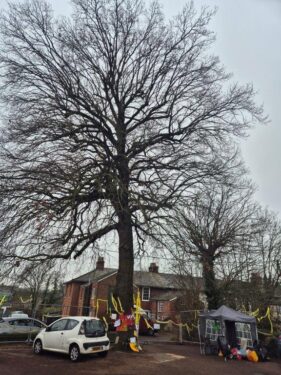 The security fencing arrived, but before it was completed, we moved in peacefully (as we remained throughout). And so the Tree Protectors’ (defiantly not Protestors’) movement was born. It grew organically, each adopting the role best suited to their skills, and providing 24/7 protective cover at the tree in all weathers, as well as other essential roles, including publicity, fund-raising and crucially a team to negotiate our case with the council, supported by our barrister Paul Powlesland. The way it all came together made me wonder just how much more successful the Suffragettes could have been if they had the organising power of WhatsApp (assuming they, as we did, rapidly developed ways of securing their networks against spies and lurkers).
The security fencing arrived, but before it was completed, we moved in peacefully (as we remained throughout). And so the Tree Protectors’ (defiantly not Protestors’) movement was born. It grew organically, each adopting the role best suited to their skills, and providing 24/7 protective cover at the tree in all weathers, as well as other essential roles, including publicity, fund-raising and crucially a team to negotiate our case with the council, supported by our barrister Paul Powlesland. The way it all came together made me wonder just how much more successful the Suffragettes could have been if they had the organising power of WhatsApp (assuming they, as we did, rapidly developed ways of securing their networks against spies and lurkers).
Nearly five weeks followed when we got to know the car park and the tree intimately. We forged friendships within our group, and positive relationships with most in the town. We were peaceful, and there was barely a raised voice in opposition. Of course there were some opposing views, mainly around the closure of the car-park and public toilets, although as became clear when last week tree surgeons moved in to trim the trees, the closures were a matter of Council choice rather than a necessity.
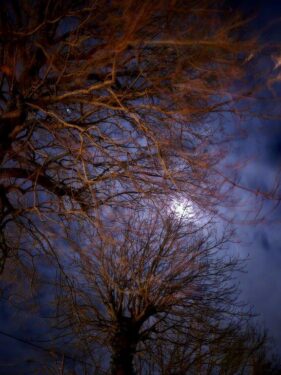 Sitting by the oak, day and night, provided lots of opportunity for observation. The tracery of the branches, whether against grey skies or blue, sunlight or moonlight, dripping with rain or wreathed in tendrils of mist. The birds using it: Robins and Great Tits singing in the branches, Woodpigeons sitting in it, Great Spotted Woodpecker, Jackdaws and Long-tailed Tits passing through, and Red Kites and Buzzards flying over. Tawny Owls hooting. Muntjacs barking and Foxes yelping and scenting at night. And many more…
Sitting by the oak, day and night, provided lots of opportunity for observation. The tracery of the branches, whether against grey skies or blue, sunlight or moonlight, dripping with rain or wreathed in tendrils of mist. The birds using it: Robins and Great Tits singing in the branches, Woodpigeons sitting in it, Great Spotted Woodpecker, Jackdaws and Long-tailed Tits passing through, and Red Kites and Buzzards flying over. Tawny Owls hooting. Muntjacs barking and Foxes yelping and scenting at night. And many more…
We saw the buds begin to swell as sap started to rise; the marcescent patches of retained leaves, rustling in every breath of breeze; got to know the mosses and lichens, the bark-life. Worlds within a world. As our friend James Canton said: ‘some 2300 species rely on oaks – and one of them is us!’
The creative flowering
F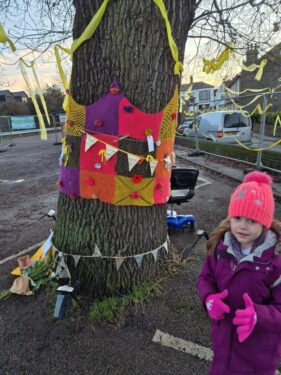 rom the very start, the oak tree was clad in knitwear, its own protective veil, along with kids’ drawings and good wishes – appropriately so as one of the main reasons we put ourselves through the cold and discomfort was for those who come after us.
rom the very start, the oak tree was clad in knitwear, its own protective veil, along with kids’ drawings and good wishes – appropriately so as one of the main reasons we put ourselves through the cold and discomfort was for those who come after us.
And very soon, other creative pursuits followed. Many thousands of photos must have been taken, some of which will be showcased in the Old Grocery gallery on 1st and 2nd March. Martin Newell contributed a couple of very powerful opinion pieces to the East Anglian Daily Times. Poems and songs were composed and performed. And then there were the visual artists, many of whom were evidently inspired by the place of the oak tree as the green heart of town – here, the lovely depictions from Richard Allen and Lorraine George.
The Age of Reason, the Age of Treason?
All in all, this was a celebration of community, sadly at odds at times with those democratically charged with serving that community. It was as if we were rediscovering the radical spirit of Essex: from Boudicca, Cnut and Wat Tyler to Billy Bragg, support for striking miners and dockers, protests against live animal exports. Folk memories that say so much more about our county than the political bigotry of the recent past.
Standing up for facts and evidence, rather than truth being what those who shout loudest or have deepest pockets say, we helped the trees past their original execution date of 15th January, then the ‘absolute final’ (spurious) Aviva demand of 1st February.
Then after two weeks on tenterhooks, of stony silence, of raised hopes cruelly dashed, on St Valentine’s Day not a massacre, but the news that our negotiation team had achieved its objective of a legal stay of execution, six weeks initially, giving time for the Protectors to examine the ‘evidence’ used to justify a death sentence and to advocate alternative solutions. All we ever wanted! In return, we agreed to vacate our Peace Camp… which we did in a matter of hours, leaving it in a cleaner state then when we arrived.
‘Twas an evening of much celebration!! We had won the first battle of the peaceful war.
Postscript
With ink barely dry on the ‘agreement’, within two days we were plunged back into turmoil. The clause in the agreement to allow us to contribute a list of preferred contractors to undertake a degree of crown reduction was reneged upon: the contractor and date were announced next working day, due to happen three days later. Purely by happenstance, the preferred contractor, Tree & Lawn Company, was high on our list as well…
Then it was announced the trees would be netted, clearly a provocative act, signifying the intent to fell the trees after the expiry of the stay of execution without legal hindrance from nesting birds. We were in Disneyland Paris at the time, so much of the queueing time was spent keeping abreast of fast-moving developments, and attempting to advise from afar. But Reason eventually prevailed…
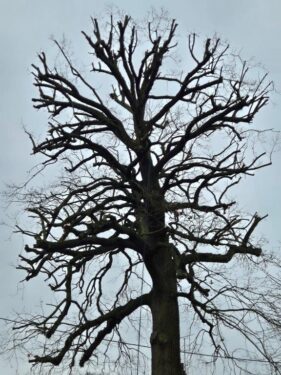 And so to the two days of crown reduction, nothing worse than a sharp haircut. T&LC did a wonderful job, in a spirit of cooperation and openness – we cannot praise them highly enough: they clearly love the trees they are charged with maintaining. Their investigation of the Horse Chestnut for roosting bats with an endoscope was exemplary. OK, so our tree is no longer the tallest kid on the block from our flat, but they left sufficient wispy twigs that it will green up well this summer, and within a couple of years should regain its pre-eminence from our viewpoint.
And so to the two days of crown reduction, nothing worse than a sharp haircut. T&LC did a wonderful job, in a spirit of cooperation and openness – we cannot praise them highly enough: they clearly love the trees they are charged with maintaining. Their investigation of the Horse Chestnut for roosting bats with an endoscope was exemplary. OK, so our tree is no longer the tallest kid on the block from our flat, but they left sufficient wispy twigs that it will green up well this summer, and within a couple of years should regain its pre-eminence from our viewpoint.
If it is allowed to live.
Think not ‘crown reduction’ but ‘crowning’ of a queen. Indeed, if it survives, this will be the Crowning of our May Queen when the leaves emerge after a tumultuous winter.
There is still much to do before we get to that stage, but I have hope. We can make a case for the primacy of evidence, open for all to examine and interpret. Surely that is a fundamental tenet of a civilized society?
Following crowning, the trees will need to recover, and the oak especially needs a helping hand. Breaking up the tarmac at its base to allow water in will reduce the need for its roots to forage widely as it recovers. This brings added benefits from reduced root damage by vehicle movements, and gives opportunities. Let’s get those kids who supported us from the outset back to plant woodland bulbs at its base, say Wild Daffodils, Wild Garlic and native Bluebells, as a positive signpost to the future after the Protectors, those on Wivenhoe Town Council and the grasping shareholders of Aviva are gone and forgotten.
And then there is the other long game. Aviva seems to be a serial offender in this sort of case across the country. Yet it is sponsoring the Woodland Trust in a big way, and at least for the forthcoming Chelsea Flower Show, the Wildlife Trusts! Blatant blood money, egregious greenwashing! C’mon, this is just not acceptable. Wildlife Trusts, Woodland Trust – would you accept money from Russia, tobacco or Big Oil? Thank you to the Essex Wildlife Trust for supporting our cause, but your umbrella body is frankly not fit for moral purpose. Would they accept funding from a convicted rapist for a women’s refuge? I rest my case.
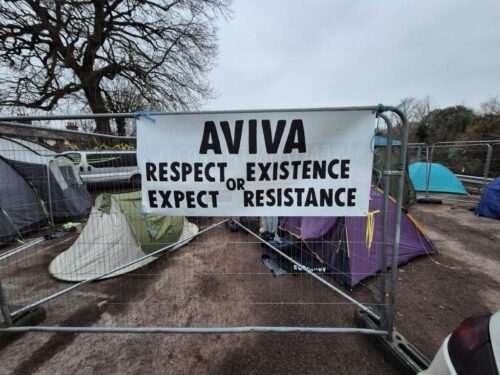 A cod translation of ‘A-viva’ from Greek and Latin would produce ‘without life’. Enough said…
A cod translation of ‘A-viva’ from Greek and Latin would produce ‘without life’. Enough said…
Epilogue
The fate of the tree is not yet known. There is much work to be done and many more tales to be told. Tales of politics and people. Unexpected kindnesses, threats and intimidation. Friendships lost and a tribe gained. A community coming together, but with deep divisions. Support and betrayal. The misuse of power and the power of the collective. Of elation and despair. Facts, evidence and reason against secrecy and half-truths. A story of a tree that became three trees, then THE trees and finally OUR trees. A very modern love story but one as old as Nature herself…
The online petition is still available to sign at Petition · Save Wivenhoe’s Old King George Oak Tree – Wivenhoe, United Kingdom · Change.org. At the time of writing it has nearly 4,300 signatures, probably mostly local, and pretty impressive for a population less than twice that.
Likewise there is a crowdfunder Save Wivenhoe’s Old King George Oak tree – a Environment crowdfunding project in Colchester by Save Wivenhoe’s Old Oak Tree. Heading towards £10,000, this is needed to provide legal advice and technical expertise necessary to achieve our aim of securing this community asset. The crowdfunder is due to close in a week’s time, but an alternative will be provided: we will need the funds if we are to have a chance of helping the Town Council stand against the overwhelming bullying of Aviva.
The tree still stands. And spring is bursting, albeit slowly…
